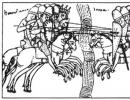The largest asteroids and their movement. Asteroids of the Solar System Presentation on the history of asteroid discoveries
Prepared by a student of grade 11B
Kornyushina Valeria

Asteroid - a small planet-like celestial body in the Solar System, moving in orbit around the Sun. Asteroids, also known like small planets, are significantly smaller in size than the planets.

Term asteroid (from ancient Greek. ἀστεροειδής - “like a star”, from ἀστήρ - “star” and εῖ̓δος - “appearance, appearance, quality”) was introduced William Herschel based on the fact that these objects, when observed through a telescope, looked like points of stars - in contrast to the planets, which when observed through a telescope, looked like disks. Exact definition of the term "asteroid" is still not established.

To date, tens of thousands of asteroids have been discovered in the Solar System. Most currently known asteroids are concentrated within the asteroid belt, located between the orbits of Mars and Jupiter. The largest asteroid in the solar system is considered Ceres, having dimensions of approximately 975 × 909 km.

Pallas
Vesta
Two other largest asteroids Pallas And Vesta have a diameter of ~500 km.

At first, asteroids were given the names of heroes Roman and Greek mythology, later the discoverers gained the right to call it whatever they wanted, for example, by their own name. At first, asteroids were given predominantly female names; only asteroids with unusual orbits (for example, Icarus, approaching the Sun closer than Mercury).

The larger and heavier the asteroid, the greater the danger it poses, but in this case it is much easier to detect it. The most dangerous asteroid at the moment is considered Apophis, with a diameter of about 300 meters, in a collision with which, in the event of an accurate hit, a large city can be destroyed, but such a collision does not pose any threat to humanity as a whole.

Meteorite - a solid body of cosmic origin that fell to the surface Earth . Most of the meteorites found weigh between several grams up to several kilograms. The largest meteorite ever found is Goba(weight 60 tons).

At the site of the fall of a large meteorite, a crater. One of the most famous craters in the world - Arizonan. It is believed that the largest meteorite crater on Earth is Wilkes Land Crater(diameter about 500 km).
Arizona Crater

The process of meteorites falling to Earth.
The meteor body enters the Earth's atmosphere at a speed of about 11-25 km/sec. It begins to warm up and glow. Due to ablation(burning and blowing away by the oncoming flow of particles of the meteoric body’s substance), the mass of the body that reaches the ground may be less than its mass at the entrance to the atmosphere. Traces of the combustion of a meteoroid in the atmosphere can be found along almost the entire trajectory of its fall. If the meteoroid does not burn up in the atmosphere, then as it slows down it loses the horizontal component of its speed. This leads to a change in the trajectory of the fall. As it slows down, the glow of the meteor body decreases and it cools down. In addition, the meteor body may break into fragments, which leads to fallout Meteor shower .

Interesting Facts.
The only documented case of a meteorite hitting a person occurred on November 30, 1954 in Alabama. A meteorite weighing about 4 kg pierced the roof of a house and ricocheted Anna Elizabeth Hodges on the arm and thigh. The woman received bruises.
1 slide

2 slide
An asteroid is a small planet-like celestial body in the Solar System moving in orbit around the Sun. Asteroids, also known as minor planets, are significantly smaller in size than planets.

3 slide
The term asteroid (from ancient Greek ἀστεροειδής - “like a star”, from ἀστήρ - “star” and εῖ δος - “appearance, appearance, quality”) was introduced by William Herschel on the basis that these objects looked like when observed through a telescope like points of stars - in contrast to planets, which look like disks when observed through a telescope. The exact definition of the term "asteroid" is still not established.

4 slide
To date, tens of thousands of asteroids have been discovered in the Solar System. Most currently known asteroids are concentrated within the asteroid belt, located between the orbits of Mars and Jupiter. The largest asteroid in the Solar System is Ceres, measuring approximately 975×909 km.

5 slide
The other two largest asteroids, Pallas and Vesta, have a diameter of ~500 km. Pallas Vesta

6 slide
At first, the asteroids were given the names of heroes of Roman and Greek mythology, later the discoverers received the right to call it whatever they wanted, for example, by their own name. At first, asteroids were given predominantly female names; only asteroids with unusual orbits (for example, Icarus, approaching the Sun closer than Mercury) received male names.

7 slide
The larger and heavier the asteroid, the greater the danger it poses, but in this case it is much easier to detect it. The most dangerous asteroid at the moment is considered to be the Apophis asteroid, with a diameter of about 300 meters, a collision with which, in the event of an accurate hit, can destroy a large city, but such a collision does not pose any threat to humanity as a whole.

8 slide
A meteorite is a solid body of cosmic origin that fell to the surface of the Earth. Most meteorites found weigh from several grams to several kilograms. The largest meteorite found is Goba (weight 60 tons).

Slide 9
A crater may form at the site where a large meteorite falls. One of the most famous craters in the world is Arizona. It is assumed that the largest meteorite crater on Earth is Wilkes Earth Crater (diameter about 500 km). Arizona Crater

10 slide
The process of meteorites falling to Earth. The meteor body enters the Earth's atmosphere at a speed of about 11-25 km/sec. It begins to warm up and glow. Due to ablation (burning and blowing away by the oncoming flow of particles of the meteorite body), the mass of the body that reaches the ground may be less than its mass at the entrance to the atmosphere. Traces of the combustion of a meteoroid in the atmosphere can be found along almost the entire trajectory of its fall. If the meteoroid does not burn up in the atmosphere, then as it slows down it loses the horizontal component of its speed. This leads to a change in the trajectory of the fall. As it slows down, the glow of the meteor body decreases and it cools down. In addition, the meteorite body may break into fragments, which leads to Meteor shower.

11 slide
Interesting Facts. The only documented case of a meteorite hitting a person occurred on November 30, 1954 in Alabama. The meteorite, weighing about 4 kg, crashed through the roof of the house and ricocheted Anna Elizabeth Hodges on the arm and thigh. The woman received bruises.
Slide 2
History of the discovery of asteroids
At the end of the 18th century. astronomers counted seven planets in the solar system: Mercury, Venus, Mars, Jupiter and Saturn were known from ancient times; in 1781, the English scientist William Herschel noticed the seventh planet, named Uranus, through a large telescope. By that time, the periods of revolution of the planets and the dimensions of their orbits had already been determined with sufficient accuracy by the methods of celestial mechanics.
And now the first day of the new, 19th century brought the long-awaited discovery. On the night of January 1, 1801, at the observatory in Palermo (island of Sicily), astronomer Giuseppe Piazzi, while compiling a catalog of stars in the constellation Gemini, discovered a faint star of approximately 7th magnitude, which was absent from star maps. A few days later, the scientist, to his surprise, noticed that the star was moving, and in the same way that a planet located further than Mars should move across the sky. Unfortunately, first illness, then unfavorable observation conditions interrupted Piazzi’s work. As a result, the faint celestial object was lost among the stars.
Slide 3
In 1804, the third representative of the family was discovered, named Juno, and in 1807, the fourth Vesta. All of them were so small that even at thousandfold magnification they looked like faint stars without a noticeable disk. Therefore, William Herschel proposed calling new planets asteroids, i.e. "star-like". In subsequent years, improvements in telescopes and the invention of photography led to an ever-increasing stream of asteroid discoveries. By 1880, about 200 of them were known, in 1923 the thousandth was noticed, by 1980 almost 2500 were included in the lists. And every year their number becomes more and more. By the way, about names. At first, minor planets were given the names of ancient Greek and Roman gods and heroes. When this “repertoire” was exhausted, female names of almost all peoples of the world were used. There probably won’t be a single reader who doesn’t have her own planet in the sky! Now, however, they have begun to deviate from this rule - there are not enough names... Planets are named quite arbitrarily, relying more on the number assigned in the data bank, which is monitored by a special commission of the International Astronomical Union. As an example, here are a few names of asteroids: 2 Pallas, 224 Oceana, 265 Anna... So far, only the largest asteroids have been discovered. There are many millions more smaller ones.
Slide 4
Asteroid belt
Slide 5
Slide 6
The orbits of the majority of numbered minor planets (98%) are located between the orbits of the planets Mars and Jupiter. Their average distances from the Sun range from 2.2 to 3.6 AU. They form the so-called main asteroid belt. All small planets, like large ones, move in a forward direction. The periods of their revolution around the Sun range from three to nine years, depending on the distance. It is easy to calculate that the linear speed is approximately 20 km/s. The orbits of many small planets are noticeably elongated. Eccentricities rarely exceed 0.4, but, for example, for asteroid 2212 Hephaestus it is 0.8. Most orbits are located close to the ecliptic plane, i.e. to the plane of the Earth's orbit. Tilts are usually a few degrees, but there are exceptions. Thus, the orbit of Ceres has an inclination of 35°, and large inclinations are also known.
Slide 7
Large asteroids
Slide 8
Asteroid Gaspra
Slide 9
The Gaspra asteroid and the Galileo spacecraft
Slide 10
Asteroid Matilda
Slide 11
Asteroid 243 Ida (Galileo image)
Slide 12
What awaits us in the event of a disaster?
Slide 13
From the dark depths of boundless space, a huge asteroid is rushing towards the Earth at great speed, threatening the death of all living things. A blow - and... For the time being, this is just a terrible fairy tale told at night to careless humanity. However, any fairy tale is a “lesson for good fellows.” Not so long ago, about a year ago, the sensational news spread around the world that on February 1, 2019, asteroid 2002 NT7 with a diameter of more than 2 km could collide with the Earth. Soon, however, scientists reported that this time nothing threatens our planet and the end of the world is postponed at least until February 1, 2060.
Slide 14
The impact of an asteroid with a diameter of about 100 m on the surface of the Earth will destroy everything within a radius of up to 1000 km from the impact site, fires will engulf vast areas, and a huge amount of ash and dust will be thrown into the atmosphere, which will then settle over several years. The sun's rays will not be able to penetrate to the surface of the planet, and a sharp cooling will destroy many species of plants and animals, and photosynthesis will stop. And when the dust finally settles and air circulation is restored, the increase in carbon dioxide in the atmosphere will cause a greenhouse effect. The temperature in the near-Earth layer will rise, polar ice will begin to melt, and most of the land will be flooded. To add insult to injury, the Earth's magnetic field will be disrupted, the dynamics of tectonic processes will change, and volcanic activity will increase.
Slide 15
- 11 A class, Kolybelskaya school
- 2007
View all slides
Slide 1
Slide 2
 At the end of the 18th century. astronomers counted seven planets in the solar system: Mercury, Venus, Mars, Jupiter and Saturn were known from ancient times; in 1781, the English scientist William Herschel noticed the seventh planet, named Uranus, through a large telescope. By that time, the periods of revolution of the planets and the dimensions of their orbits had already been determined with sufficient accuracy by the methods of celestial mechanics. And now the first day of the new, 19th century brought the long-awaited discovery. On the night of January 1, 1801, at the observatory in Palermo (island of Sicily), astronomer Giuseppe Piazzi, while compiling a catalog of stars in the constellation Gemini, discovered a faint star of approximately 7th magnitude, which was absent from star maps. A few days later, the scientist, to his surprise, noticed that the star was moving, and in the same way that a planet located further than Mars should move across the sky. Unfortunately, first illness, then unfavorable observation conditions interrupted Piazzi’s work. As a result, the faint celestial object was lost among the stars.
At the end of the 18th century. astronomers counted seven planets in the solar system: Mercury, Venus, Mars, Jupiter and Saturn were known from ancient times; in 1781, the English scientist William Herschel noticed the seventh planet, named Uranus, through a large telescope. By that time, the periods of revolution of the planets and the dimensions of their orbits had already been determined with sufficient accuracy by the methods of celestial mechanics. And now the first day of the new, 19th century brought the long-awaited discovery. On the night of January 1, 1801, at the observatory in Palermo (island of Sicily), astronomer Giuseppe Piazzi, while compiling a catalog of stars in the constellation Gemini, discovered a faint star of approximately 7th magnitude, which was absent from star maps. A few days later, the scientist, to his surprise, noticed that the star was moving, and in the same way that a planet located further than Mars should move across the sky. Unfortunately, first illness, then unfavorable observation conditions interrupted Piazzi’s work. As a result, the faint celestial object was lost among the stars.
Slide 3
 In 1804, the third representative of the family was discovered, named Juno, and in 1807, the fourth Vesta. All of them were so small that even at thousandfold magnification they looked like faint stars without a noticeable disk. Therefore, William Herschel proposed calling new planets asteroids, i.e. "star-like". In subsequent years, improvements in telescopes and the invention of photography led to an ever-increasing stream of asteroid discoveries. By 1880, about 200 of them were known, in 1923 the thousandth was noticed, by 1980 almost 2500 were included in the lists. And every year their number becomes more and more. By the way, about names. At first, minor planets were given the names of ancient Greek and Roman gods and heroes. When this “repertoire” was exhausted, female names of almost all peoples of the world were used. There probably won’t be a single reader who doesn’t have her own planet in the sky! Now, however, they have begun to deviate from this rule - there are not enough names... Planets are named quite arbitrarily, relying more on the number assigned in the data bank, which is monitored by a special commission of the International Astronomical Union. As an example, here are a few names of asteroids: 2 Pallas, 224 Oceana, 265 Anna... So far, only the largest asteroids have been discovered. There are many millions more smaller ones. Asteroid name Diameter, km 1 Ceres 1003 2 Pallas 608 4 Vesta 538 10 Hygia 450 31 Euphrosyne 370 704 Interamnia 350 511 David 323 65 Cybele 309 52 Europa 289 451 Patientia 276 15 Eunomia 272 16 Psyche 250 48 Doris 250 92 Ondine 250
In 1804, the third representative of the family was discovered, named Juno, and in 1807, the fourth Vesta. All of them were so small that even at thousandfold magnification they looked like faint stars without a noticeable disk. Therefore, William Herschel proposed calling new planets asteroids, i.e. "star-like". In subsequent years, improvements in telescopes and the invention of photography led to an ever-increasing stream of asteroid discoveries. By 1880, about 200 of them were known, in 1923 the thousandth was noticed, by 1980 almost 2500 were included in the lists. And every year their number becomes more and more. By the way, about names. At first, minor planets were given the names of ancient Greek and Roman gods and heroes. When this “repertoire” was exhausted, female names of almost all peoples of the world were used. There probably won’t be a single reader who doesn’t have her own planet in the sky! Now, however, they have begun to deviate from this rule - there are not enough names... Planets are named quite arbitrarily, relying more on the number assigned in the data bank, which is monitored by a special commission of the International Astronomical Union. As an example, here are a few names of asteroids: 2 Pallas, 224 Oceana, 265 Anna... So far, only the largest asteroids have been discovered. There are many millions more smaller ones. Asteroid name Diameter, km 1 Ceres 1003 2 Pallas 608 4 Vesta 538 10 Hygia 450 31 Euphrosyne 370 704 Interamnia 350 511 David 323 65 Cybele 309 52 Europa 289 451 Patientia 276 15 Eunomia 272 16 Psyche 250 48 Doris 250 92 Ondine 250
Slide 4

Slide 5

Slide 6
 The orbits of the majority of numbered minor planets (98%) are located between the orbits of the planets Mars and Jupiter. Their average distances from the Sun range from 2.2 to 3.6 AU. They form the so-called main asteroid belt. All small planets, like large ones, move in a forward direction. The periods of their revolution around the Sun range from three to nine years, depending on the distance. It is easy to calculate that the linear speed is approximately 20 km/s. The orbits of many small planets are noticeably elongated. Eccentricities rarely exceed 0.4, but, for example, for asteroid 2212 Hephaestus it is 0.8. Most orbits are located close to the ecliptic plane, i.e. to the plane of the Earth's orbit. Tilts are usually a few degrees, but there are exceptions. Thus, the orbit of Ceres has an inclination of 35°, and large inclinations are also known.
The orbits of the majority of numbered minor planets (98%) are located between the orbits of the planets Mars and Jupiter. Their average distances from the Sun range from 2.2 to 3.6 AU. They form the so-called main asteroid belt. All small planets, like large ones, move in a forward direction. The periods of their revolution around the Sun range from three to nine years, depending on the distance. It is easy to calculate that the linear speed is approximately 20 km/s. The orbits of many small planets are noticeably elongated. Eccentricities rarely exceed 0.4, but, for example, for asteroid 2212 Hephaestus it is 0.8. Most orbits are located close to the ecliptic plane, i.e. to the plane of the Earth's orbit. Tilts are usually a few degrees, but there are exceptions. Thus, the orbit of Ceres has an inclination of 35°, and large inclinations are also known.
Slide 7

Slide 8

Slide 9

Slide 10

Slide 11

Slide 12

Slide 13
 From the dark depths of boundless space, a huge asteroid is rushing towards the Earth at great speed, threatening the death of all living things. A blow - and... For the time being, this is just a terrible fairy tale told at night to careless humanity. However, any fairy tale is a “lesson for good fellows.” Not so long ago, about a year ago, the sensational news spread around the world that on February 1, 2019, asteroid 2002 NT7 with a diameter of more than 2 km could collide with the Earth. Soon, however, scientists reported that this time nothing threatens our planet and the end of the world is postponed at least until February 1, 2060.
From the dark depths of boundless space, a huge asteroid is rushing towards the Earth at great speed, threatening the death of all living things. A blow - and... For the time being, this is just a terrible fairy tale told at night to careless humanity. However, any fairy tale is a “lesson for good fellows.” Not so long ago, about a year ago, the sensational news spread around the world that on February 1, 2019, asteroid 2002 NT7 with a diameter of more than 2 km could collide with the Earth. Soon, however, scientists reported that this time nothing threatens our planet and the end of the world is postponed at least until February 1, 2060.
Slide 14
 The impact of an asteroid with a diameter of about 100 m on the surface of the Earth will destroy everything within a radius of up to 1000 km from the impact site, fires will engulf vast areas, and a huge amount of ash and dust will be thrown into the atmosphere, which will then settle over several years. The sun's rays will not be able to penetrate to the surface of the planet, and a sharp cooling will destroy many species of plants and animals, and photosynthesis will stop. And when the dust finally settles and air circulation is restored, the increase in carbon dioxide in the atmosphere will cause a greenhouse effect. The temperature in the near-Earth layer will rise, polar ice will begin to melt, and most of the land will be flooded. To add insult to injury, the Earth's magnetic field will be disrupted, the dynamics of tectonic processes will change, and volcanic activity will increase.
The impact of an asteroid with a diameter of about 100 m on the surface of the Earth will destroy everything within a radius of up to 1000 km from the impact site, fires will engulf vast areas, and a huge amount of ash and dust will be thrown into the atmosphere, which will then settle over several years. The sun's rays will not be able to penetrate to the surface of the planet, and a sharp cooling will destroy many species of plants and animals, and photosynthesis will stop. And when the dust finally settles and air circulation is restored, the increase in carbon dioxide in the atmosphere will cause a greenhouse effect. The temperature in the near-Earth layer will rise, polar ice will begin to melt, and most of the land will be flooded. To add insult to injury, the Earth's magnetic field will be disrupted, the dynamics of tectonic processes will change, and volcanic activity will increase.
Using the Internet, prepare a presentation on “The Largest Asteroids and Their Motion.”
This rather large celestial body (diameter 975 * 909 km) has been many things since its discovery: both a full-fledged planet of the solar system and an asteroid, and since 2006 it has acquired a new status - a dwarf planet. The last name is the most correct, since Ceres is not the main one in its orbit, but only the largest in the asteroid belt. It was discovered quite by accident by the Italian astronomer Piazzi in 1801. Ceres has a spherical shape (unusual for asteroids) with a rocky core and a crust of water ice and minerals. The distance between the closest point in the orbit of this solar satellite and the Earth is 263 million kilometers. Its path lies between Mars and Jupiter, but there is some tendency towards chaotic movement (which increases the chances of collisions with other asteroids and a change in orbit). It is not visible to the naked eye from the surface of our planet - it is only a 7th magnitude star. Pallas Size 582 * 556 kilometers, and it is also part of the asteroid belt. The angle of Pallas' rotation axis is very high - 34 degrees (for other celestial bodies it does not exceed 10). Pallas moves in an orbit with a large degree of deviation, which is why its distance to the Sun changes all the time. This is a carbon asteroid, rich in silicon and is of interest in the future from the point of view of mining. Vesta This is the heaviest asteroid to date, although it is smaller in size than the previous ones. Due to the composition of the rock, Vesta reflects 4 times more light than Ceres, although its diameter is half that. It turns out that this is the only asteroid whose movement can be observed with the naked eye from the surface of the Earth when it approaches once every 3-4 years to a minimum distance of 177 million kilometers. Its movement is carried out along the inner part of the asteroid belt and never crosses our orbit. Interestingly, with a length of 576 kilometers, there is a crater with a diameter of 460 kilometers on its surface. In general, the entire asteroid belt around Jupiter is a giant quarry where celestial bodies collide with each other, fly into pieces and change their orbits - but how Vesta survived a collision with such a large object and retained its integrity remains a mystery. Its core consists of heavy metal, and its crust is made of light rock. Hygeia This asteroid does not intersect with our orbit and revolves around the Sun. A very dim celestial body, although it has a diameter of 407 kilometers, was discovered later than the others. This is the most common type of asteroid, with carbonaceous content. Typically, observing Hygia requires a telescope, but at its closest approach to Earth, it can be seen with binoculars.






